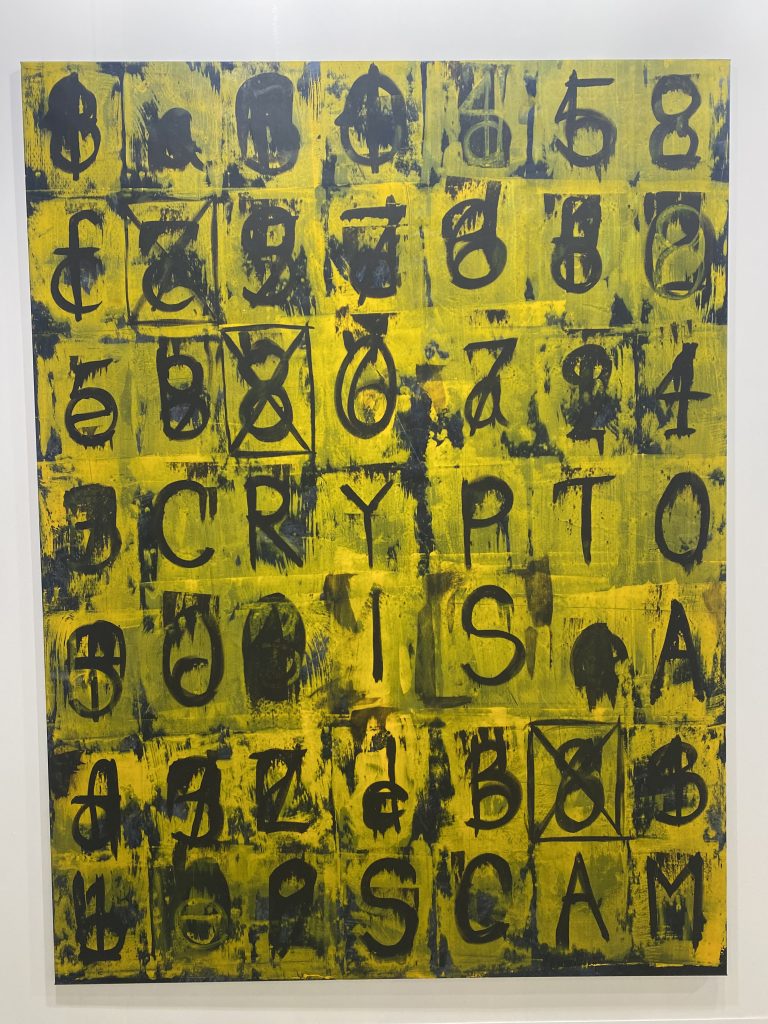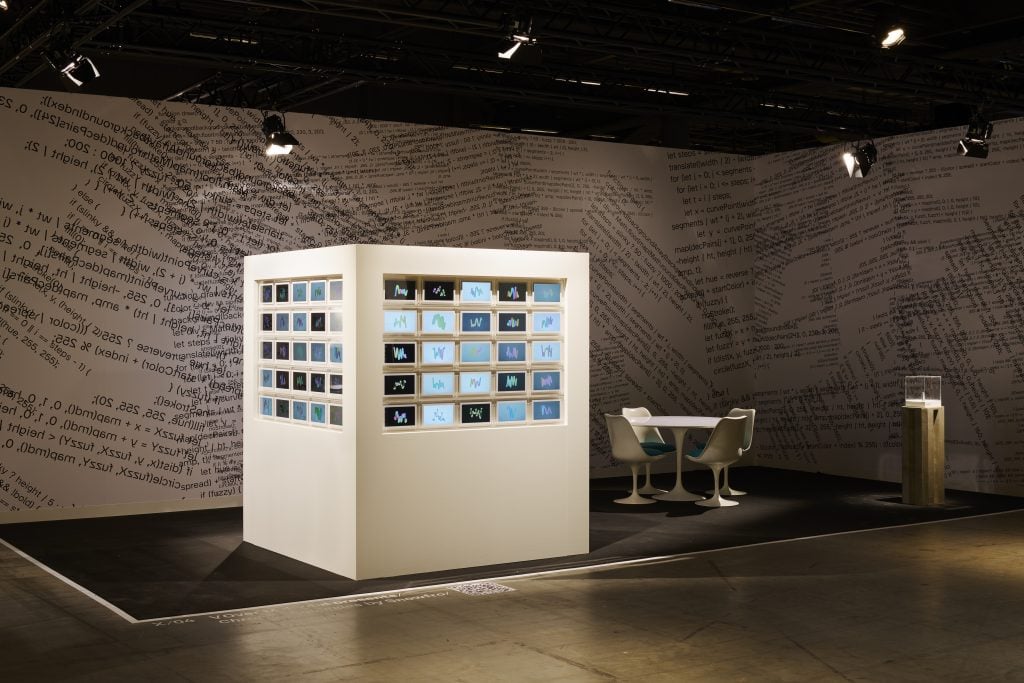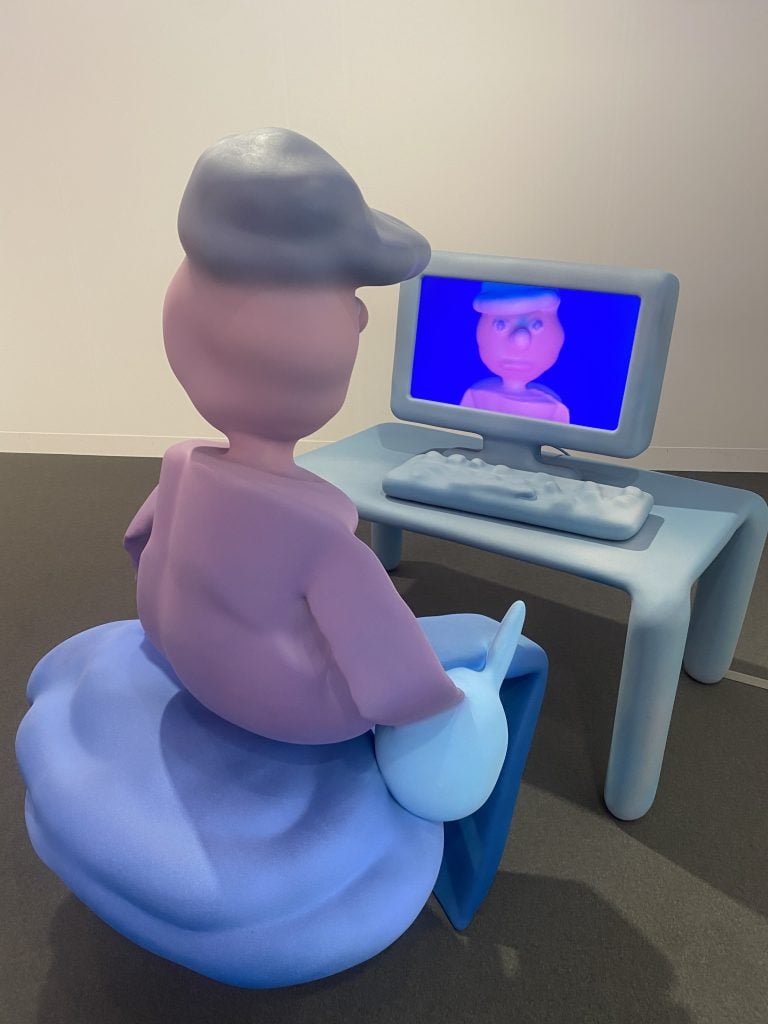Crypto heavyweights appeared on Art Basel, but NFTs were scarce as Bitcoin continues to plunge
As a new crypto winter arrived just in time for Art Basel, there was a lot of non-fungible gossip (and a few sales!) To report from the world’s premier art fair, which opened this week.
Along with the usual amount of art glitter, several large balers of the NFT and crypto art scenes appeared at the fair this year. Ryan Zurrer, founder of Dialectic.ch and collector of works by the likes of Beeple and Refik Anadol, was spotted walking at the main fair. And Beeple himself could be seen through the fair with Carolyn Christov-Bakargiev, director of the Castello di Rivoli, where his very first sculpture, Human one, is currently on display. Meanwhile, Niclas Castello, the ancestor of the infamous gold cube that became the Castello Coin cryptocurrency, spent an evening curled up at a corner table on Les Trois Rois.
Unlike Art Basel Miami Beach in December, which felt more like an NFT party than a traditional art fair, the Swiss edition felt significantly less bullish on NFTs.
That feeling is becoming more and more widespread throughout the world. After reaching a peak of $ 69,000 in November 2021, the price of Bitcoin fell to as low as $ 20,080 yesterday, the third day of the fair. Ethereum, the cryptocurrency most associated with NFTs, has not fared much better, falling to as low as $ 1,030 below Art Basel, far from the previous high of $ 4,800. Both major cryptocurrencies have fallen nearly 70 percent since April.
TDespite the boom-bust cycle in the crypto market, it seems that the art market is finally starting to get around to digital (and “fygital”) art.
At the main fair, the Cologne- and Berlin-based Galerie Nagel Draxler, which famously sold the first NFT ever at Art Basel last year (a work by Olive Allen), toned down its crypto offerings by pairing them with traditional art. The Nagel Draxler stand presented two crypto-related works of art, including three NFTs by Kenny Schachter.
Schachter was seen in green and yellow-striped Adidas training pants walking around the fair and wondering aloud what the collapsing price of Ethereum would mean for the NFTs he had on offer. Schachter’s Duchamp wallpaper, available as NFT, was now probably not even worth the paper it was printed on, a bit like the German-German mark in 1923 (also used as the wallpaper).
Meanwhile, Kevin Abosch, the Irish concept artist and crypto art pioneer, sold a painting (without NFT) called Crypto is a scam, an acrylic graphite on canvas that gave € 75,000 ($ 79,000), which went to a named buyer from the crypto room, according to the gallery’s co-founder Saskia Draxler.

Kevin Abosch, Crypto is a scam (2021). Courtesy of Galerie Nagel Draxler.
Draxler added that she felt that the fair became more inviting for collectors of digital art, as well as works of traditional art that refer to crypto themes. “We’re trying to merge the two worlds,” Draxler said. “Soon enough, everyone will have a wallet for digital assets, but right now I feel we are in the middle of the fourth industrial revolution, and Art Basel is and will always be a pulse for many of these changes.”
Jeffrey Deitch, in a massive three-level booth, showed a work by Refik Anadol, the NFT star known for AI-powered computer painting and several blockbusters at Christie’s recently. However, it was not an NFT, but one digital AI painting of ocean currents, and Deitch only accepted fiat currency.
Upstairs, a single NFT by Austin Lee was displayed on a screen next to a playful resin sculpture. It was priced at € 50,000 ($ 53,000) and remained unsold on day three of the fair.
Deitch himself was sharp when it came to discussing the impact of NFTs on the art market. “I’m not interested in NFTs, I’m just interested in significant art,” he said.
Tempo undoubtedly had the biggest coup in the NFT market under Art Basel, after selling several versions of Jeff Koons’ Moon phases NFT project, each priced at $ 2 million and comes with a sculptural accompaniment.
Outside the Unlimited section, a stand by Tezos featured Herbert W. Franke, the 95-year-old pioneer in generative art, whose work was presented alongside younger artists such as Aleksandra Jovanic, Ryan Bell, Eko33 and Sam Tsao. Franke’s work, with title MONDRIAN (1979), was originally developed as a dynamic image and sound program for Texas Instruments.
The work allows selective construction of individual images using a dynamic sequence where one can intervene interactively at any time. The program also made it possible, way back in the late 1970s, to design a dynamic image that can constantly change by itself and whose algorithms run under random influence. The work stands as one of the earliest forms of natural digital generative art. Although none of the work in the Tezos stand was for sale, it provided a useful showcase for educating visitors about the rich history of new media art.

Erick Calderon, Chromie Squiggles, as part of the Art Blocks collection 0. Courtesy V Over M Digital.
Art critic and curator Anika Meier told Artnet News how impressed she was with the Tezos presentation in Basel. “Herbert W. Franke is a universal genius,” she said. “His pioneering spirit made him one of the first computer artists more than six decades ahead of his time.”
Meier also helps the London-based art platform Circa and Tezos are organizing Marina Abramovic’s first NFT, which will be released this summer. (Details about it will be presented on June 18, at an artist talk between Abramovic and Circa’s artistic director, Josef O’Connor, at the Tezos booth.)
At the nearby Volta trade fair, the Artsted platform presented an NFT bar featuring works by the likes of Francesco Vullo, Xiaoling Jin, Domiano Fasso and Maria Giovanna Morelli.
“We decided to design the NFT bar as a place where people can feel comfortable and just hang out and relax,” said Maryna Rybakova, CEO and founder of Artsted. She added that the show was not a commercial effort, rather it stood as a place where new collectors could come and learn about NFTs.
“As part of Generation Z, I am convinced that the future of the world is digital. The next generation of collectors is at the forefront of this new technology, she said. “Resources are being transferred from the ‘old’ market to the ‘new’ market.”
George Bak, founder of the Tokengate NFT consulting firm and co-founder of the recent NFT Art Day in Zurich (co-organized with EAT / Engadin Art Talks’ founder Katharina de Vaivre), also read the fair with Tom Rieder, co. founder of the sales platform elementum.art. Rieder noted that while the crypto scene in Switzerland is primarily centered around Zug, the ecosystem around NFTs and platforms is beginning to expand throughout Switzerland. Rieder told Artnet News that “NFTs are starting to make progress in Basel, although I think New York and Miami are still at the top of the pile when it comes to buying and selling digital artifacts.”
Bak, who is also organizing a sale of generative NFTs at Phillips in July, said he notices a move towards “phygital”, a neologism that refers to works that have both an NFT (digital component) and a physical one. Sculptures that also include NFTs, for example, are Koons’s Moon landing (2022) and Beeple’s Human One. Bak said that despite the recent move towards phygital works, he decided to buy an NFT of generative art from Squiggles series by Erick Calderon, founder of Art Blocks, in the stand of the V Over M digital stand on display at the Design Miami trade fair in Basel.
The digital stand V Over M, which collaborated with Infinite Objects for the presentation of the art blocks Chromie Squiggles, staged an installation of natural digital generative art. The design of the stand included the wallpaper taken from Art Block’s source code, as well as 100 small digital screens mounted on four walls. Although the gallery was not willing to provide exact sales details, Adam Lindemann, the gallery’s owner, told Artnet News that they have had 20 requests for coins. “Overall, it has been great, just ask Roger Federer – he loved them!” in Lindemann.

Austin Lee, Mirror (2022). Courtesy of Jeffrey Deitch.
Joe Saavedra, founder of Infinite Objects, largely agreed, saying that he believes the NFT market is evolving towards digital natural content that also has a strong presence in the physical space.
“When we partnered with Beeple on his second ever release on Nifty Gateway, we explored how including a physical twin with an NFT sale could help attract new collectors unfamiliar with blockchain,” he said. He added that although his original concept was to create a product that “was a vessel for videos”, he was quick to point out that “the objects we create are immutable, just like the blockchain itself, which means we operate create scarcity, origin and make digital art collectible. ”
Infinite Objects was launched in 2019 and has so far completed hundreds of projects with some of the world’s leading digital artists. Earlier this year, it was responsible for building SuperRare’s pop-up gallery in New York, and on June 16, it launched an exclusive NFT membership. With Infinite Objects revenue up 500 percent in the last year alone, backed by $ 6 million in start-up funding from major players in the NFT area, including Dapper Labs founder Roham Gharegozlou, it doesn’t look like the sky is falling for companies like Infinite Objects.
With images of monkeys selling for tens of millions of dollars, Takashi Murakami’s crashing NFTs, and the recent descent into a crypto winter, what will the future hold for NFTs? And where do they stand in the pantheon of Art Basel? Judging by this year’s fair, perhaps the future is closer than we think. In addition to a few discounts, if you take into account the long, cold crypto winter.
Correction: An earlier version of this article said that Kenny Schachter’s pants were “rainbow colored” while in fact they were black with green and yellow stripes.


